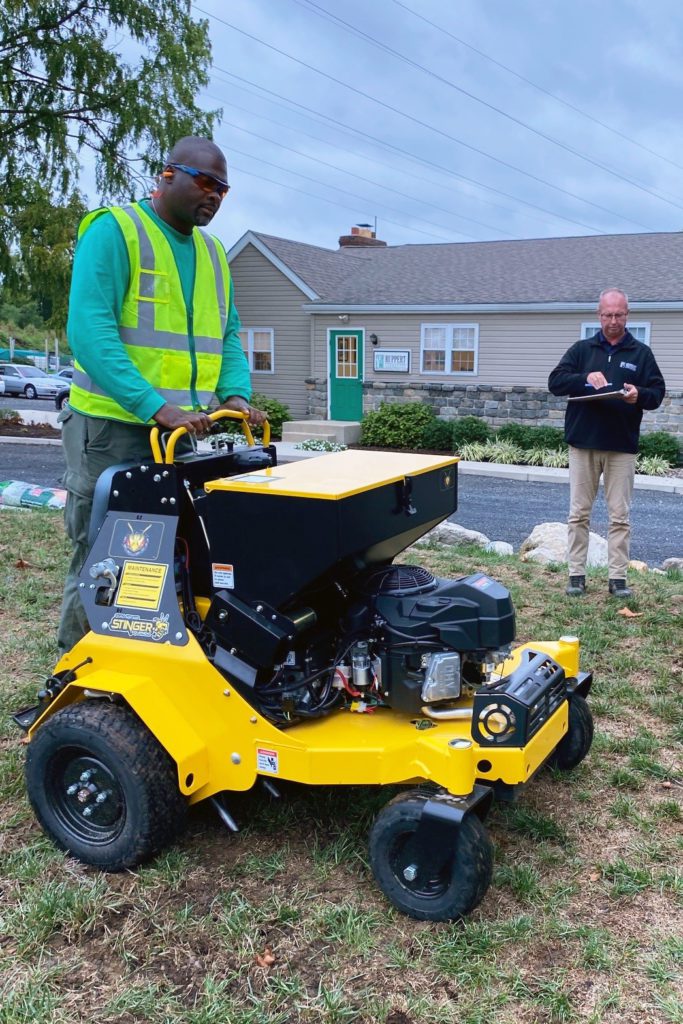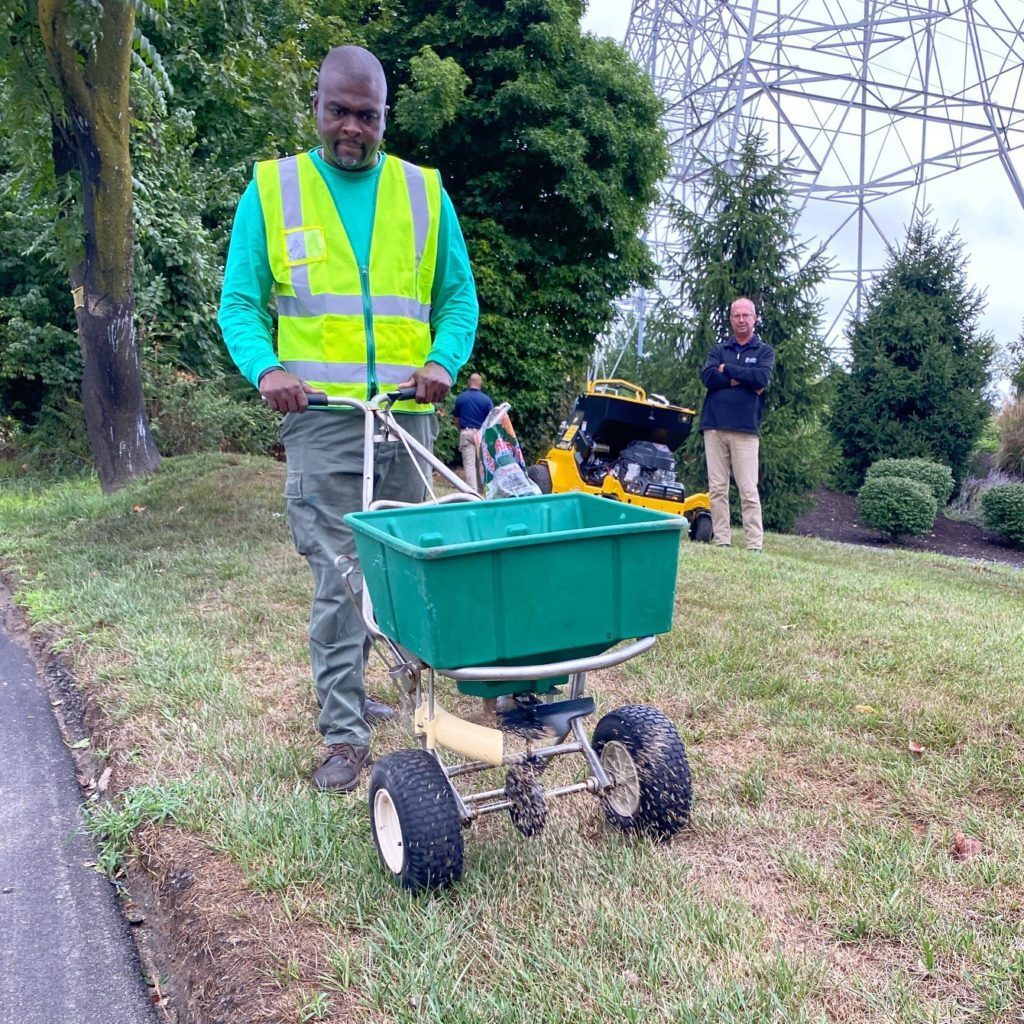By Joe Ketterer, Director of Quality and Efficiency
 Turf renovation—comprised of a properly timed sequence of operations like aeration, topdressing, and over-seeding—helps increase turf health and viability. This process takes place in late summer or early fall when air temperatures are typically cooler, but soil temperatures are still warm enough to promote good germination rates, assuming adequate moisture is available.
Turf renovation—comprised of a properly timed sequence of operations like aeration, topdressing, and over-seeding—helps increase turf health and viability. This process takes place in late summer or early fall when air temperatures are typically cooler, but soil temperatures are still warm enough to promote good germination rates, assuming adequate moisture is available.
The cost of seed has risen 200% over last year, meaning it is more important than ever to make sure we get the best return on our customer’s investment. Communication is key to balancing the customer’s budget with high-impact results. This may warrant a conversation about prioritizing areas to renovate instead of proposing a renovation of the entire turf acreage, creating a detailed maps for crews to follow so that we focus our attention in the right areas.
 Another way to mitigate costs while improving the look and health of the turf is to perform rescue chemical treatments for things like crabgrass, summer annual broadleaf weeds, and sedges two weeks prior to actual aerating and overseeding operations. Chemical applications should be scheduled two to four weeks ahead to allow time for herbicides to “break down” and not negatively affect germination of the new seed.
Another way to mitigate costs while improving the look and health of the turf is to perform rescue chemical treatments for things like crabgrass, summer annual broadleaf weeds, and sedges two weeks prior to actual aerating and overseeding operations. Chemical applications should be scheduled two to four weeks ahead to allow time for herbicides to “break down” and not negatively affect germination of the new seed.
Why Renovate?
There are a variety of reasons why we may suggest a turf renovation to address deficiencies in a portion of the property (or in some cases the entire area of turf), including but not limited to:
- Poorly established turf at initial installation
- Loss of density due to drought, insects, or disease
- Infestation of weeds and undesirable grasses
- Excessive foot traffic or construction damage
- To introduce new turfgrass varieties which can better withstand environmental stress
Soil Testing
Once you determine a need for turf renovation, the first step is to test the soil. The importance of soil testing and maintaining the proper balance of soil chemistry cannot be overstated, as it is a key component to the success of basic aeration and overseeding operations. A soil test, which should be performed in mid-summer, provides valuable information, including nutrient levels (phosphorous and potassium are crucial to seedling development); pH level (ideally between 6.0 and 7.0); and Cation Exchange Capacity (CEC), which is essentially a measure of the soil’s ability to attract and hold nutrients.
Too often in our industry, this important step is overlooked because of the time it takes to get results and recommendations back from an appropriate and dependable soil testing lab. The actual cost of the test is insignificant when compared to the cost of a failed turf renovation. Additional nutrients, fertilizer, or organic matter may be added to the newly seeded area after turf renovation to try to address soil chemistry concerns, but really these should be done in late summer before renovations begin. The ideal solution, as we often say, is to do it right the first time and begin with the end in mind!
Aftercare Program
 Now, it’s our job to follow the proper steps to increase the chances of having good germination and development of the newly seeded grasses. Coordination of watering, mowing, and turf chemical applications is key to a successful renovation in order to reduce weed competition and pave the way for the newly germinated seedlings.
Now, it’s our job to follow the proper steps to increase the chances of having good germination and development of the newly seeded grasses. Coordination of watering, mowing, and turf chemical applications is key to a successful renovation in order to reduce weed competition and pave the way for the newly germinated seedlings.
So, what can we do to ensure success?
- Water— Be aware of natural rainfall amounts as well as irrigation levels and adjust as needed to keep the seed bed moist but not oversaturated to avoid seedling mortality. A good rule of thumb is:
- For the first four weeks: less water, more frequently
- After four weeks: more water, less frequently
- Mow— Just because the grass is new does not mean it shouldn’t be cut as needed, however we need to be mindful of a few things:
- Start with a higher cutting height to avoid damaging the new seedlings.
- Avoid leaving excessive clippings—or leaves, if later in the season—because they can smother seedlings and deprive them of access to oxygen, sunlight and moisture.
- Downsize equipment where necessary to avoid damage from the weight and turning of heavy machines, which may tear up the turf and destroy seedlings leaving an unsightly bald spot.
- Fertilize— Treat the new turf in accordance with soil test results and prevailing nutrient management laws, with a complete starter fertilizer that should be applied at same time as the seeding OR a fertilizer with post emergent weed control only if necessary (allow a minimum of 4-6 weeks during which the seedlings have been mowed 2-3 times before using herbicides).
- Protect— Ask the client for help in keeping any vehicles and equipment off the turf and reducing foot traffic to a minimum.
Turf renovation is a process of sequential events that requires attention to detail in order to get the best results from your efforts. If a turf renovation was completed by the book, and the aftercare program followed correctly, you should have a healthy stand of turf that will lay dormant in winter and return healthier than ever come spring.